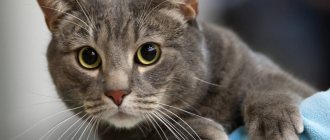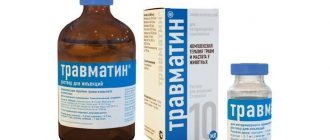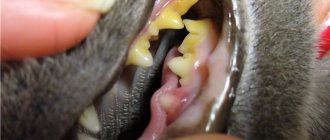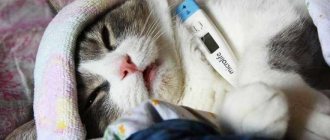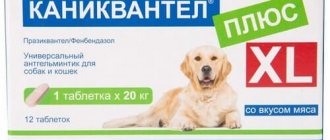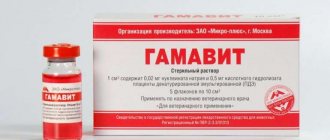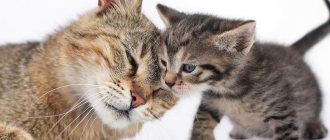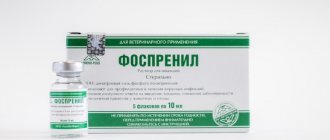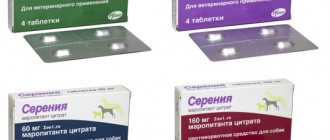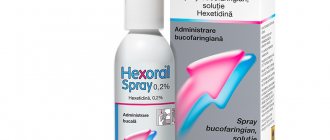COMPOUND
Active substance:
- Feliferon for cats, according to the instructions, 1 ml contains feline interferon with antiviral activity of 400,000 IU as an active ingredient
Excipients:
- dextran-40 50.00 mg
- sodium salt of ethylenediaminetetraacetic acid 0.07 mg
- sodium acetate 1.64 mg
- sodium chloride 5.84 mg
- polysorbate-20 0.10 mg
- glacial acetic acid about 0.0045 ml
- water for injection up to 1 ml
"Feliferon" solution for injection, 1 bottle × 2.5 ml
I. General information
1. Trade name of the medicinal product: Feliferon® solution for injection (solutio Feliferoni pro injectionibus).
International nonproprietary name: cat interferon.
2. Dosage form: solution for injection.
Feliferon injection solution in 1 ml contains cat interferon as an active ingredient with an antiviral activity of 400,000 international units (IU), excipients: glacial acetic acid about 0.0045 ml (until the pH is established from 4.5 to 5.0); 1.64 mg sodium acetate; 5.84 mg sodium chloride; 0.10 mg polysorbate-20; 0.07 mg sodium salt of ethylenediaminetetraacetic acid; 50.00 mg dextran 40 and water for injection up to 1 ml.
In appearance, the drug is a colorless, transparent or slightly opalescent liquid.
3. Feliferon solution for injection is produced packaged in 2.5 ml glass bottles of 3 ml, sealed with rubber stoppers, reinforced with aluminum caps.
4. The drug should be stored in the manufacturer’s sealed packaging, protected from direct sunlight, separately from food and feed, at a temperature of 2 °C to 8 °C. Single freezing to a temperature of minus 25 °C is allowed.
The shelf life of the medicinal product, subject to storage conditions in a closed package, is 2 years from the date of manufacture, after opening the bottle - no more than 5 days.
Feliferon injection solution should not be used after the expiration date.
5. Feliferon injection solution should be stored out of the reach of children.
6. Unused drug is disposed of in accordance with legal requirements.
II. Pharmacological properties
7. Pharmacological group: immunomodulators.
Feliferon injection solution has antiviral and immunostimulating effects.
The mechanism of action is to suppress the reproduction of DNA and RNA viruses in infected cells, increase the resistance of healthy cells of the body to infection by viruses, enhance the phagocytic activity of macrophages and increase the specific cytotoxicity of lymphocytes.
In terms of the degree of impact on the body, Feliferon solution for injection is classified as a low-hazard substance (hazard class 4 according to GOST 12.1.007-76); in recommended doses it does not have a skin-irritant or resorptive-toxic effect.
III. Application procedure
8. Feliferon injection solution is used for therapeutic and prophylactic purposes in cats for gastrointestinal, acute respiratory and other diseases of viral or mixed etiology, as well as for anemia and hypovitaminosis, invasive diseases, poisoning, in the postpartum and postoperative periods and secondary immunodeficiency .
It is not recommended to use the drug Feliferon solution for injection after vaccination of animals for 10 days.
9. Contraindications to the use of the drug Feliferon solution for injection are individual hypersensitivity of the animal to interferons (including a history), severe allergic and autoimmune diseases.
10. Feliferon solution for injection is administered intramuscularly.
For prophylactic purposes (if there is a threat of infection), the drug is prescribed at a dose of 200,000 IU per 1 animal, twice with an interval of 48 hours.
For the treatment of viral, bacterial and mixed diseases of cats, the drug is administered in a daily dose of 200,000 IU, for 5-7 days in combination with antibiotics, serum and immunoglobulin preparations, in accordance with the instructions for their use.
In severe cases of the disease and mixed infections, it is recommended to increase the average therapeutic dose by 2 times - 400,000 IU.
11. Symptoms of overdose when using the drug were not identified.
12. The specific effects of the drug upon first use or upon withdrawal have not been established.
13. Avoid skipping the next dose of the drug, as this may lead to a decrease in therapeutic effectiveness. If one dose is missed, it is necessary to administer it as soon as possible; then the interval between administrations of the drug does not change.
14. There are no side effects or complications when using the drug Feliferon solution for injection in accordance with these instructions. In case of increased individual sensitivity and the occurrence of allergic reactions, the drug should be discontinued and the animal should be prescribed antihistamines and symptomatic therapy.
15. Feliferon injection solution should not be mixed in the same syringe with other medications. Combined use with any chemotherapeutic and immunobiological agents (serum and immunoglobulin) is allowed.
16. Feliferon injection solution is not intended for use in productive animals.
IV. Personal prevention measures
17. When working with Feliferon injection solution, you should follow the general rules of personal hygiene and safety precautions provided for when working with medications.
18. In case of accidental contact of the medicinal product with the skin or mucous membranes of the eyes, they must be rinsed with plenty of running water. People with hypersensitivity to the components of the drug should avoid direct contact with Feliferon solution for injection. If allergic reactions occur or if the drug accidentally enters the human body, you should immediately contact a medical facility (bring with you the instructions for use of the drug or the label).
19. Empty drug containers must not be used for household purposes; they must be disposed of with household waste.
PHARMACOLOGICAL PROPERTIES OF FELIFERON
Pharmacological group: immunomodulators, drugs with antiviral activity. Feliferon for cats has an immunostimulating and antiviral effect.
The mechanism of action consists of:
- increased phagocytic activity of macrophages in cats
- increasing the specific cytotoxicity of lymphocytes
- increasing the resistance of healthy cells of the cat’s body to infection with viruses
- in suppressing the reproduction of RNA and DNA viruses in infected cells
According to the degree of impact on the cat’s body, Feliferon is classified as a low-hazard substance
(grade 4), in recommended doses does not have a skin irritant or resorptive toxic effect.
Drug analogues
"Feliferon" is an effective, but expensive and not always available drug. Veterinarians may suggest the following drugs that have a similar therapeutic effect:
- "Fosprenil" is available in the form of a solution for intramuscular injection. Dosage: 0.2 ml of the drug per 1 kg of animal weight. Indications for use are similar to Feliferon, however, the drug can be used not only for the treatment of cats.
- "Neoferon" is an effective immunomodulator. The injection solution is prescribed at the rate of 0.5 ampoule volume per animal.
- "Immunofan" contains a complex of active substances that not only have an immunomodulatory effect, but are also hepatoprotectors.
The choice and prescription of the drug depends entirely on the opinion of the veterinarian regarding the effectiveness of a particular drug in a given case.
Why use Feliferon to treat cats?
According to the instructions, feliferon is designed for the treatment of viral diseases of cats. Field studies of cats with calicivirus infection have shown a reduction in the severity and duration of clinical signs associated with the virus. The drug has also been used in the adjunctive therapy of cats with infectious peritonitis with uncertain clinical results.
Feliferon for cats has been used experimentally in the treatment of feline viral infections, including leukemia, immunodeficiency and coronavirus infection.
Feline interferon given prophylactically or therapeutically to cats experimentally infected with FIP does not reduce mortality. However, the high-dose protocol resulted in transient suppression of clinical signs and decreased serum antibody titers to FIP with increased survival time (weeks) compared to untreated cats. There are no good studies on the effect of this treatment on spontaneously occurring FIP infection, although one protocol has been described using human interferon alpha 30 IU/day orally for 7 days on alternating weeks for 6–7 weeks.
Feliferon in cats is indicated for the treatment of herpes keratitis.
Trials are currently underway to examine the potential benefits of interferon therapy for feline chronic gingivostomatitis.
Advantages
- Immunostimulating effect. Its essence is the activation of leukocytes, which are responsible for eliminating viral infections.
- Antiviral effect. Protein synthesis in affected cells slows down.
- Feline interferon is specifically designed for these animals, which contributes to more effective treatment and the formation of positive dynamics.
- The animal does not get used to the medicine.
- There are no side effects associated with the toxicity of the product.
- There are no restrictions on the age of the animal. Feliferon can be used for kittens from the first days of life.
INDICATIONS
Feliferon is prescribed to cats according to the instructions for use for therapeutic and prophylactic purposes for:
- feline herpesvirus (rhinotracheitis)
- panleukopenia
- calicivirus
- anemia and hypovitaminosis
- in the postoperative period
- in the postpartum period
- secondary immunodeficiency
- gastrointestinal
- invasive diseases
- acute respiratory
- poisoning
- other diseases of viral or mixed etiology
When is it appointed?
The drug turned out to be very effective against coronavirus infection in animals.
In veterinary practice, based on studies of the effectiveness of the drug, a group of scientists from the Scientific and Technological Institute uses Feliferon for coronavirus, calcivirosis and other dangerous viral diseases. For kittens and adults, Feliferon is also prescribed for the treatment of bacterial diseases of the digestive system, vitamin deficiency, anemia, acute respiratory infections, helminthic infestation, as well as after surgery in order to improve the immune system and reduce the risk of complications. In addition, the indication for the use of Feliferon is secondary immunodeficiency and the need to protect the body from viral diseases, for example, during an epidemic.
MODE OF APPLICATION
Feliferon solution for injection is administered intramuscularly to cats. If there is a threat of infection, the drug is prescribed at a dose of 200,000 IU per animal, twice with an interval of 48 hours. For the treatment of cats with viral, bacterial and mixed diseases, Feliferon is administered in a daily dose of 200,000 IU, for 5-7 days in combination with antibiotics, serum and immunoglobulin preparations, in accordance with the instructions for their use.
In severe cases of the disease and mixed infections, it is recommended to increase the average therapeutic dose by 2 times - 400,000 IU.
No overdose symptoms have been identified when using the drug. Avoid missing the next dose of Feliferon in cats, as this may lead to a decrease in therapeutic effectiveness. If one dose is missed, it is necessary to administer it to the cat as soon as possible, then the interval between administrations of the drug does not change.
Contraindications and side effects
It is important to check with your doctor for how many days to inject Feliferon, taking into account the cat’s condition, in order to speed up the animal’s recovery as much as possible. As for side effects, when using the solution in accordance with the instructions, they are not observed.
If individual intolerance is detected, it is necessary to stop giving injections to the cat, and also consult a doctor to prescribe antihistamines. Taking Feliferon is not recommended:
- after suffering from severe autoimmune and allergic diseases;
- within 10 days after vaccination;
- in case of disturbances in the functioning of the circulatory system;
- in case of malfunction of the nervous system.
Did you know? Australia is the world leader in the number of cat lovers: there are 9 cats per 10 inhabitants in this country.
Prevention measures:
If allergic reactions occur or if the drug accidentally enters the human body, you should immediately contact a medical facility (bring the instructions or label with you).
People with hypersensitivity to the components of the drug should avoid direct contact with the drug. When working with Feliferon for cats, you should follow the general rules of personal hygiene and safety precautions provided for when working with medications.
If a person accidentally comes into contact with the medicinal product with the skin or mucous membranes of the eyes, they must be rinsed with plenty of running water.
Empty drug bottles must not be used for household purposes; they must be disposed of with household waste.
Storage conditions
To preserve the healing properties of Feliferon solution, the drug must be stored correctly. The medicine in its entire packaging is stored in a place out of direct sunlight. The packaging of the drug is not placed together with food products. Also, the product should be stored out of the reach of children. Vials with the drug should be located in a place where the temperature is maintained from 2 to 8 degrees above zero. The solution can be frozen once at a temperature not lower than 25 degrees. The shelf life of the drug is 24 months, subject to storage conditions. The solution in an opened bottle is stored for no more than 5 days. It is prohibited to treat an animal with expired Feliferon. Unspent remains of the drug are disposed of in accordance with the standards for neutralization of pharmacological products.
How to give an injection to an animal
Visit the profile section of our Medical Examination forum or leave your feedback in the comments below. More opinions means more useful information, it will be useful to someone. If there are good and interesting videos on the topic of the article, write and I will insert them into this publication.
Learn about essential antimicrobials in animals
- Trichopolum instructions for veterinary medicine
- Instructions for the use of the antibiotic Baytril in animals
- Instructions for use of metronide
- Instructions for ceftriaxone preparations for animals
- Use of Metrogyl in veterinary medicine
- Instructions for doxycycline in animals
- Metronidazole (Metronidazole) for animals (instructions for use in veterinary medicine, doses, indications and contraindications)
- Atovaquone (ATOVAQUONE)
- Azithromycin, instructions for animal therapy
^Top
Consumer Reviews
I have always been skeptical of domestic manufacturers. Cheap could not be high quality. Therefore, I was surprised when the veterinarian prescribed a course of Feliferon to restore the cat after giving birth. After the injections, she became interested in kittens, leaving the house and eating.
Anastasia
While relaxing at the dacha, the cat contracted an infectious disease. He was constantly vomiting and had diarrhea. I had to urgently return to the city and go to the vet. The doctor made a disappointing diagnosis and prescribed treatment. I believe that it was Feliferon that helped the animal recover.
Andrey
The cat suddenly caught a cold.
She didn't react to anything. The veterinarian prescribed treatment. Among the drugs was Feliferon. I was skeptical about the prescription, but completed the course. On the second day, the pet came to life and began to behave actively. He asked me to eat, drank water and responded to me. Elena
Adverse reactions
When Feliferon is used correctly, treatment proceeds well and no negative effects occur. Otherwise, cats may encounter a number of undesirable consequences, which will require them to refuse injections of the immunostimulant. Thus, if diarrhea, vomiting, rash, or itching occurs, therapy should not be continued, but measures must be taken quickly to alleviate the pet’s condition. Veterinarians recommend giving the purr an antiallergic drug, and if symptoms persist, then symptomatic treatment.
